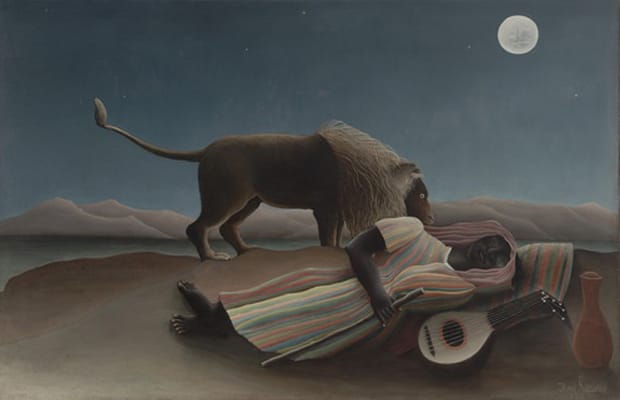Sleep poem
Last night.
Last night.
Winds howled
Rain slapped the windows
Lightening flashed
Thunder crashed.
Sirens wailed: cops,
fire truck, ambulance.
As usual I didn’t hear a thing
I’m a sound sleeper.
“Sound”? Actually, no sound.
And dreams? REM sleep?
It must happen but I rarely remember
More than little tinkly bits
Like wind chimes next door.
I sleep deeply, peacefully,
Restfully -- most of the time.

The Sleeping Gypsy -- Henri Rousseau
Rapid eye movement sleep (REM sleep), characterized by random movement of the eyes, suspended central homeostasis (allowing large fluctuations in respiration, thermoregulation, and circulation which do not occur in any other modes of sleeping or waking), low muscle tone throughout the body, and a propensity to dream vividly, is unique in mammals and birds. It is sometimes called paradoxical sleep or desynchronized sleep because of its physiological similarities to waking states (including rapid, low-voltage desynchronized brain waves). REM sleep is physiologically different from the other phases of sleep, which are collectively referred to as non-REM or synchronized sleep. REM and non-REM phases alternate within one sleep cycle, which lasts about 90 minutes in adult human, but as the cycles continue they shift towards a higher proportion of REM sleep; the transition to REM sleep brings marked physical changes, beginning with electrical bursts called ponto-geniculo-occipital waves originating in the brain stem. In slow-wave sleep the eyes can drift apart, but they move in tandem during REM, and the posterior areas of the brain are more coherent with each other (as are the right and left hemispheres, especially during lucid dreams), but frontal and posterior areas are less coherent in most frequencies, a fact which has been cited in relation to the chaotic experience of dreaming. Despite the name, however, most of the eye movements in REM sleep are less rapid than those normally exhibited by waking humans, are shorter in duration and more likely to loop back to their starting point.
ReplyDeleteSponsored by the Wander Company, which manufactured Ovaltine (a milk flavoring product made with malt extract, sugar, and whey) and hoped to promote it as a remedy for insomnia, Nathaniel Kleitman wrote the seminal 1939 book "Sleep and Wakefulness," making him the father of modern sleep research. In 1953 one of his graduate students at the University of Chicago, Eugene Aserinsky, attached sleepers up to an early version of an electroencephalogram machine, which scribbled across 1⁄2 mile (800 m) of paper each night; he noticed that several times each night the sleepers went through periods when their eyes darted wildly back and forth. Kleitman and Aserinsky thus introduced the world to "rapid-eye movement" sleep and its correlation with dreaming but were not very interested in that aspect of brain activity. However, another of Kleitman's graduate students, William C. Dement, had an interest in psychiatry and dreams. Over the following decade at Mount Sinai Hospital in New York, Dement pursued his interest and discovered and named the five stages of sleep. (With Christian Guilleminault, in the 1980s he also developed the Apnea Hypopnea Index used to diagnose sleeping disorders; and with Mary Carskadon invented the Multiple Sleep Latency Test used to measure sleepiness. Dement is regarded as the father of sleep medicine. According to him, "Dreaming permits each and everyone of us to be quietly and safely insane every night of our lives.") Kleitman also continued to make contributions to the field of sleep research and was especially interested in "rest-activity" cycles, leading to many fundamental findings on circadian and ultradian rhythms; he proposed the existence of a basic rest activity cycle during both sleep and wakefulness. As for Aserinsky, on 22 July 1998 he fell asleep while driving and was killed when his car hit a tree north of San Diego, California.